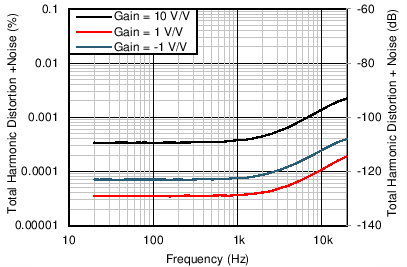SBOS855E January 2017 – December 2022 OPA1677 , OPA1678 , OPA1679
PRODUCTION DATA
- 1 Features
- 2 Applications
- 3 Description
- 4 Revision History
- 5 Pin Configuration and Functions
- 6 Specifications
- 7 Detailed Description
-
8 Application and Implementation
- 8.1 Application Information
- 8.2 Typical Applications
- 8.3 Power Supply Recommendations
- 8.4 Layout
- 9 Device and Documentation Support
- 10Mechanical, Packaging, and Orderable Information
Package Options
Mechanical Data (Package|Pins)
Thermal pad, mechanical data (Package|Pins)
- DRG|8
Orderable Information
3 Description
The single-channel OPA1677, dual-channel OPA1678, and quad-channel OPA1679 (OPA167x) op amps offer higher system-level performance over legacy op amps commonly used in audio circuitry.
The OPA167x amplifiers achieve a low 4.5-nV/√Hz noise density and low distortion of 0.0001% at 1 kHz, which improves audio signal fidelity. These devices also offer rail-to-rail output swing to within 800 mV with a 2-kΩ load, which increases headroom and maximizes dynamic range.
To accommodate the power-supply constraints of many types of audio products, the OPA167x operate over a very-wide supply range of ±2.25 V to ±18 V (or 4.5 V to 36 V) on only 2 mA of supply current. These op amps are unity-gain stable and have excellent dynamic behavior over a wide range of load conditions, allowing the OPA167x to be used in many audio circuits.
The OPA167x amplifiers use completely independent internal circuitry for lowest crosstalk and freedom from interactions between channels, even when overdriven or overloaded.
| PART NUMBER | CHANNELS | PACKAGE(1) |
|---|---|---|
| OPA1677 | Single | SOIC (8) |
| SOT-23 (5) | ||
| OPA1678 | Dual | SOIC (8) |
| VSSOP (8) | ||
| SON (8) | ||
| OPA1679 | Quad | SOIC (14) |
| TSSOP (14) | ||
| QFN (16) |
 THD+N vs Frequency (2-kΩ
Load)
THD+N vs Frequency (2-kΩ
Load)